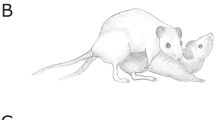Abstract
In male rats, androgen deficiency during a critical hypothalamic organizational period was shown to give rise to a predominantly female-differentiated brain, homosexual behavior, and demonstration of a positive estrogen feedback effect. A positive estrogen feedback effect was also induced in intact homosexual men in contrast to intact heterosexual and bisexual men. Thus in 21 homosexual men an intravenous injection of 20 mg Presomen (Premarin) produced a significant decrease of serum LH levels followed by an increase above initial LH values. In 20 heterosexual and in five bisexual men, by contrast, intravenous estrogen administration, while producing a significant decrease of the serum LH level, was not followed by an increase above the initial LH values. Using a radioimmunoassay, plasma testosterone levels and 24-hr urinary excretions of unconjugated testosterone of adult homosexual men were found to be in the normal range as observed in heterosexual men. This finding suggests that homosexual men possess a predominantly female-differentiated brain which may be activated to homosexual behavior by normal or approximately normal androgen levels in adulthood.
Similar content being viewed by others
References
Arimura, A., and Schally, A. V. (1971). Augmentation of pituitary responsiveness to LH-releasing hormone (LH-RH) by estrogen.Proc. Soc. Exptl. Biol. Med. 136:290–293.
Debeljuk, L., Arimura, A., and Schally, A. V. (1972). Effect of testosterone and estradiol on the LH and FSH release induced by LH-releasing hormone (LH-RH) in intact male rats.Endocrinology 90:1578–1581.
Döcke, F., and Dörner, G. (1965). The mechanism of the induction of ovulation by oestrogens.J. Endocrinol. 33:491–499.
Döcke, F., and Dörner, G. (1966). Tierexperimentelle Untersuchungen zur Ovulationsauslösung mit Gonadotropinen und Östrogenen. 4. Mitt.: Zur neurohormonalen Regulation der Ovulation.Zbl. Gynäkol. 88:273–282.
Dörner, G. (1967). Tierexperimentelle Untersuchungen zur Frage einer hormonalen Pathogenese der Homosexualität.Acta Biol. Med. Germ. 19:569–584.
Dörner, G. (1969). Zur Frage einer neuroendokrinen Pathogenese, Prophylaxe und Therapie angeborener Sexualdeviationen.Deutsch. Med. Wschr. 94:390–396.
Dörner, G. (1972).Sexualhormonabhängige Gehirndifferenzierung und Sexualität (Sex Hormone Dependent Brain Differentiation and Sexuality), VEB Gustav Fischer Verlag, Jena, and Springer-Verlag, Wien/New York.
Dörner, G., and Döcke, F. (1964). Sex-specific reaction of the hypothalamo-hypophysial system of rats.J. Endocrinol. 30:265–266.
Dörner, G., and Staudt, J. (1969). Structural changes in the hypothalamic ventromedial nucleus of the male rat following neonatal castration and androgen treatment.Neuroendocrinology 4:278–281.
Dörner, G., and Staudt, J. (1972). Vergleichende morphologische Untersuchungen der Hypothalamusdifferenzierung bei Ratte und Mensch.Endokrinologie 59:152–155.
Dörner, G., Rohde, W., and Baumgarten, G. (1971). Bestimmung des genetischen Geschlechts des Foeten durch fluoreszenz mikroskopischen Nachweis des Y-Chromosoms in Fruchtwasserzellen.Acta Biol. Med. Germ. 26:1095–1098.
Dörner, G., Rohde, W., and Krell, L. (1972). Auslösung eines positiven Ostrogenfeedback-Effekt bei homosexuellen Männern.Endokrinologie 60:297–301.
Dörner, G., Rohde, W., Baumgarten, G., Herter, U., Halle, H., Gruber, G., Rössner, P., Bergmann, K. H., Götz, F., and Zillmann, R. (1973a). Zur pränatalen Geschlechtsbestimmung in Fruchtwasser und peripheren mütterlichen Blut durch fluoreszenzmikroskopischen Nachweis des Y-Chromosoms.Zbl. Gynäkol. 95:625–634.
Dörner, G., Stahl, F., Rohde, W., Halle, H., Rössner, P., Gruber, D., and Herter, U. (1973b). Radioimmunologische Bestimmung des Testosterongehalts in Fruchtwasser männlicher and weiblicher Feten.Endokrinologie 61:317–320.
Hohlweg, W. (1934). Veränderungen des Hypophysenvorderlappens und des Ovariums nach Behandlung mit grossen Dosen von Follikelhormon.Klin. Wschr. 13:92–95.
Illig, R., Pluznik, S., Bambach, M., and Prader, A. (1975). Studies on the effect of synthetic luteinizing hormone-releasing hormone (LH-RH) in children. In Dörner, G. (ed.),Endocrinology of Sex Johann Ambrosius Barth, Leipzig, in press.
Karsch, F. J., Dierschke, D. J., and Knobil, E. (1973). Sexual differentiation of pituitary function: Apparent difference between primates and rodents.Science 179:484–486.
Kinsey, A. C. (1941). Homosexuality: Criteria for a hormonal explanation of the homosexual.J. Clin. Endocrinol 1:424–428.
Nillius, S. J., and Wiede, L. (1971). Induction of a midcycle-like peak of luteinizing hormone in young women by exogenous oestradiol-17β.J. Obstet. Gynaecol. Brit. Commonw. 78:822–827.
Rohde, W., Dörner, G., Knappe, G., Guntermann, S., Groot-Wassink, K., Zillmann, R., and Zywotteck, D. (1974). Erfahrungen mit einem Radioimmunoassay zur Bestimmung von LH und HCG.Zbl. Gynäkol. 96:321–337.
Stahl, F., Dörner, G., Poppe, I., Rohde, W., Knappe, G., Stober, B., and Raabe, B. (1975). Radioimmunologische Bestimmungen von unkonjugiertem Testosteron im Plasma und Harn.Endokrinologie, in press.
Stearns, E. L., Winter, J. S. D., and Fairman, C. (1973). Positive feedback effect of progestin upon serum gonadotropins in estrogen-primed castrate men.J. Clin. Endocrinol. Metab. 37: 635–638.
Swelheim, T. (1965). The influence of a single high dose of oestradiol benzoate on the ICSH-content in the serum of gonadectomized male and female rats.Acta Endocrinol. (Kbh.) 49:231–238.
Tsai, C. C., and Yen, S. S. C. (1971). Acute effects of intravenous infusion of 17β-estradiol on gonadotropin release in pre- and post-menopausal women.J. Clin. Endocrinol. 32:766–771.
Van de Wiele, R. L., Bogumil, F., Dyrenfurth, I., Ferin, M., Jewelewicz, R., Warren, M., Rizkallah, J., and Mikhail, G. (1970). Mechanisms regulating the menstrual cycle in women.Rec. Progr. Hormone Res. 26:63–95.
Author information
Authors and Affiliations
Rights and permissions
About this article
Cite this article
Dörner, G., Rohde, W., Stahl, F. et al. A neuroendocrine predisposition for homosexuality in men. Arch Sex Behav 4, 1–8 (1975). https://doi.org/10.1007/BF01541882
Issue Date:
DOI: https://doi.org/10.1007/BF01541882




